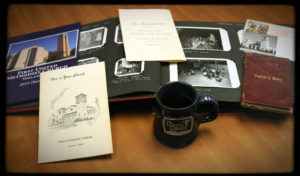Posted on Jan 3, 2017 in From The Archives |
In 2010, a new book by Neill MacGregor, entitled A History of the World in 1000 Objects, used a selection of items from the British Museum to create a unique perspective view of two million years of human history. MacGregor explained that he chose a collection of artifacts from the museum “that previous civilizations have left behind, often accidentally” as his “prism” for examining the past. This idea of constructing a historical narrative around a set of artifacts caught on and similar works soon appeared. Richard Kurin selected items from the Smithsonian for his history of America in 101 objects. Harold Holzer chose 50 items to explain the American Civil War.
These histories do offer a different angle for viewing the past–a bit mosaic, a bit fragmented. Less connected than more traditional narratives, the different artifacts nevertheless become “pages” in a story about yesterdays. What makes these accounts more interesting is the tangible nature of these objects. They are three dimensional. They can be held, examined, walked around (at least in theory–many are too valuable to actually touch).
Even more enticing, they are actual survivors from those yesterdays. They were there. They played a role in the events narrated. Sometimes, they are singular and famous. “This was Abraham Lincoln’s hat.” Sometimes, they are general. “That was a guidebook for 1920s highway travelers.”
What they have in common is that they contain a fragment of the larger story of the group, the organization, the society, the culture that produced them. And, when we connect the fragments preserved in each of these items, we rediscover that story. We can “read” it for ourselves.
So, what about the First Methodist story? Can we reconstruct it from some of the objects “accidentally” left behind?

I think we can. As I have worked on a history of this church, I have excavated some interesting “stuff.” Some is worthy of being in the archive; some perhaps not. Some items have clear provenience–that is, where they came from, how they were created, and what they mean. Others are more obscure. Dates are missing. Names are gone. Only fragments remain.
Yet, there are more than enough objects to help tell the story of this church. I have chosen ten, distributed across time, to provide a short version of that story. Some of them you will recognize. Some you have probably never seen. Some are unique; some are general. Each contains fragments of the past embedded within it.
Using this ten-item “prism,” I will share with you a look at over 130 years of Methodist life and works in Midland.
–Jim Collett, Church Historian
[Next: Bonds and Blueprints]

Jim,
Your stuff intrigues me. Looking forward. . . .